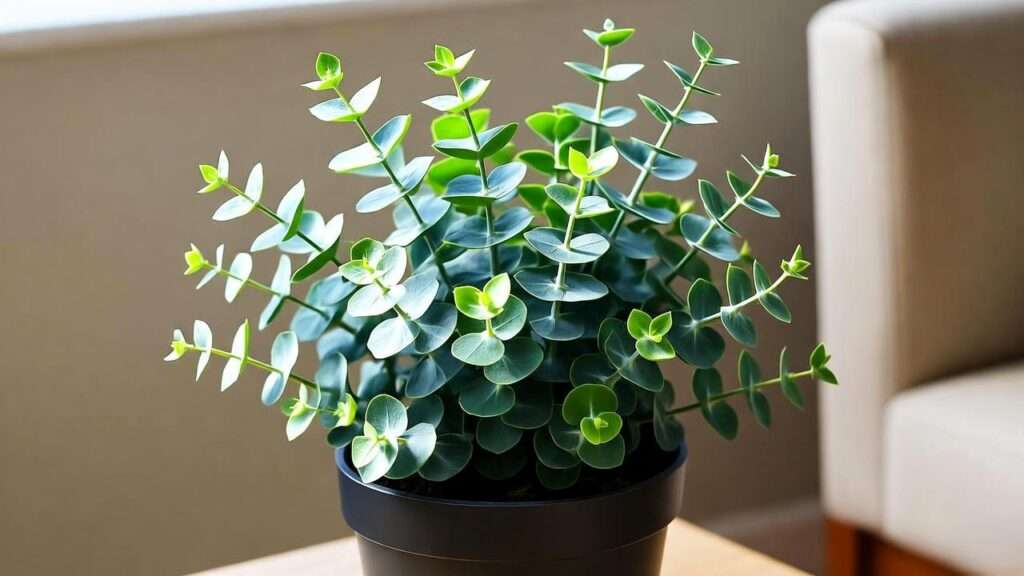Imagine filling your home with the refreshing, spa-like scent of a eucalyptus plant indoor, its silvery-green leaves cascading elegantly from a stylish pot. This aromatic beauty isn’t just a feast for the eyes—it’s a low-maintenance, air-purifying powerhouse that can transform your living space. Whether you’re a beginner or a seasoned plant parent, growing a eucalyptus plant indoors is a rewarding way to bring nature inside. In this comprehensive guide, I’ll share expert-backed tips to help you nurture a thriving indoor eucalyptus, tackling common challenges and unlocking its full potential. As a plant care specialist with over a decade of experience, I’ve cultivated countless eucalyptus plants indoors, and I’m excited to guide you on this green journey! 🌸
Eucalyptus plants are prized for their unique fragrance, aesthetic appeal, and health benefits, like air purification and stress relief. However, many beginners worry about their care requirements. Fear not—this article is your ultimate resource for mastering indoor eucalyptus care, ensuring your plant thrives for years. From choosing the right variety to troubleshooting issues, we’ll cover everything you need to know. Let’s dive in and make your home a eucalyptus haven! 🌿
1. Understanding the Eucalyptus Plant: What Makes It Special? 🌸
1.1. Types of Eucalyptus Suitable for Indoor Growing
Eucalyptus plants, native to Australia, come in over 700 species, but not all are suited for indoor environments. For beginners, I recommend starting with varieties like Eucalyptus gunnii (Cider Gum) or Eucalyptus citriodora (Lemon-Scented Gum). These are compact, adaptable, and perfect for indoor spaces. Eucalyptus gunnii boasts round, silvery leaves with a fresh scent, while Eucalyptus citriodora offers a zesty lemon fragrance. Both grow slower indoors, reaching 2–4 feet in pots, making them ideal for apartments or small homes. Their manageable size and lush foliage make them standout choices for indoor greenery. 🌱
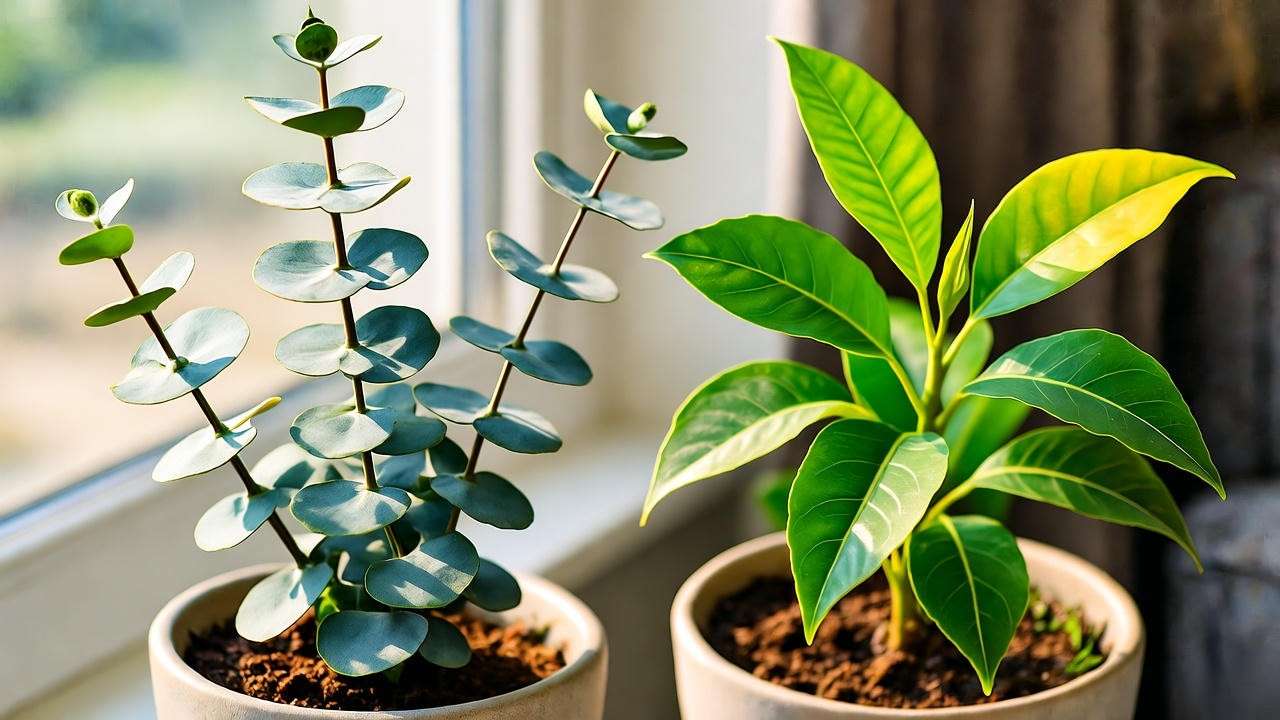
1.2. Benefits of Growing Eucalyptus Indoors
Why choose a eucalyptus plant for your home? Beyond its stunning looks, eucalyptus is a natural air purifier, filtering toxins and improving indoor air quality. Its aromatic leaves release a soothing scent, perfect for aromatherapy and stress relief. Studies suggest eucalyptus vapors can even support respiratory health, making it a thoughtful addition to bedrooms or living spaces. Plus, its unique texture and color add a modern, boho-chic vibe to any decor, elevating your space effortlessly. 🌿
1.3. Common Challenges for Indoor Eucalyptus
Many beginners assume eucalyptus is tricky to grow indoors, but with the right care, it’s surprisingly manageable. Common challenges include overwatering, insufficient light, or pest issues like spider mites. This guide will equip you with practical solutions to these problems, ensuring your eucalyptus thrives. By understanding its needs upfront, you’ll avoid pitfalls and enjoy a healthy, vibrant plant. Let’s start with selecting the perfect eucalyptus for your home! 🏡
2. Choosing the Right Eucalyptus Plant for Your Home 🏡
2.1. Where to Buy a Healthy Eucalyptus Plant
Finding a healthy eucalyptus plant is the first step to success. Look for reputable nurseries, garden centers, or trusted online retailers like Etsy or specialized plant shops. Inspect plants for vibrant, evenly colored leaves and sturdy stems. Avoid plants with yellowing, wilting, or spotted foliage, as these may indicate stress or pests. Check the roots if possible—avoid root-bound plants with circling roots, as they may struggle to adapt. Pro tip: Local nurseries often have fresher stock, and you can ask staff for care advice. 🌱
2.2. Size and Space Considerations
Eucalyptus plants vary in size, so match your choice to your available space. For small apartments, a young Eucalyptus gunnii in a 6–8-inch pot is perfect, growing to about 2–3 feet indoors. Larger spaces can accommodate a mature plant in a 10–12-inch pot, which may reach 4 feet. Ensure your pot has drainage holes to prevent waterlogging, a common cause of eucalyptus failure. Measure your space and consider placement near a bright window to meet its light needs. 🌞
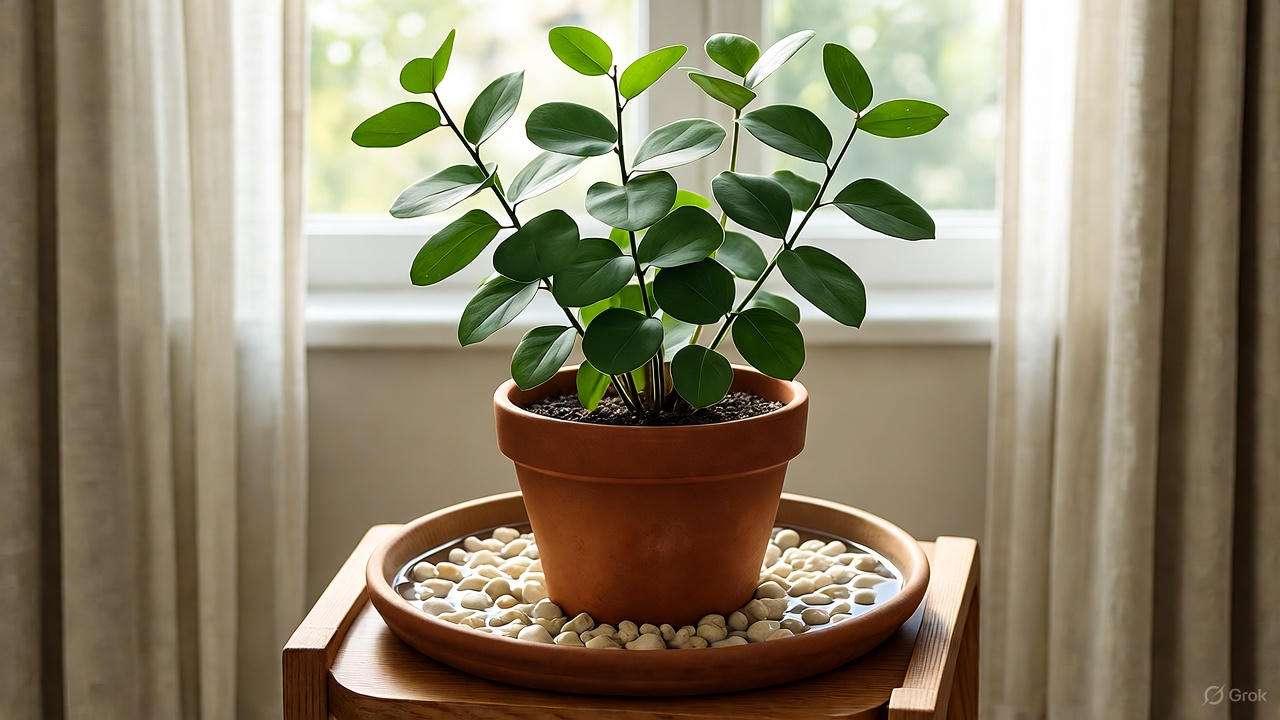
2.3. Expert Tip: Start Small for Success
As a plant care expert, I always recommend starting with a smaller eucalyptus plant, especially for beginners. Smaller plants adapt better to indoor conditions and are easier to manage as they grow. Look for a plant about 12–18 inches tall to start. Water sparingly at first, and place it in a bright spot to encourage healthy root development. This approach sets you up for long-term success and a thriving plant. 🌿
3. Essential Care Tips for Your Indoor Eucalyptus Plant 🌞
3.1. Light Requirements: Getting the Balance Right
Light is the lifeblood of your eucalyptus plant indoor. These plants crave bright, indirect sunlight for 6–8 hours daily. A south- or west-facing window is ideal, but avoid direct, scorching sun that can burn leaves. If you notice leggy growth or pale leaves, your plant may need more light. In low-light homes, consider a full-spectrum grow light (10,000–20,000 lumens) placed 12–18 inches above the plant. Rotate your eucalyptus every few weeks to ensure even growth. 🌞
3.2. Watering: How Much and How Often? 💧
Overwatering is the number one mistake eucalyptus owners make. Water your plant thoroughly, but let the top 1–2 inches of soil dry out between waterings. For a 6-inch pot, this might mean watering every 7–10 days, depending on humidity and temperature. Use a moisture meter or your finger to check soil dryness. Overwatered eucalyptus shows yellowing leaves or soggy soil, while underwatered plants have droopy, dry leaves. Always use a pot with drainage holes and empty the saucer after watering to prevent root rot. 💦
3.3. Soil and Potting: Setting the Foundation
Eucalyptus thrives in well-draining, slightly acidic soil (pH 6.0–6.5). Mix two parts potting soil with one part perlite or sand for optimal drainage. Avoid heavy, water-retaining soils like pure peat. Choose a pot with drainage holes—terracotta is great for wicking excess moisture. Repot every 1–2 years or when roots start circling the pot’s base. When repotting, gently loosen roots and use fresh soil to give your plant a nutrient boost. 🌱
3.4. Temperature and Humidity: Mimicking Eucalyptus’s Natural Habitat 🌡️
Eucalyptus plants prefer temperatures between 65–75°F (18–24°C), making them perfect for most indoor environments. Avoid placing them near cold drafts, heaters, or air vents, which can stress the plant. They thrive in moderate humidity (40–60%). If your home is dry, especially in winter, use a pebble tray filled with water or a humidifier near the plant. Mist leaves occasionally, but don’t overdo it to avoid fungal issues. A stable environment keeps your eucalyptus happy and healthy. 🌿
3.5. Fertilizing: Nourishing Your Plant
Feed your eucalyptus with a balanced liquid fertilizer (10-10-10) every 4–6 weeks during the growing season (spring and summer). Dilute to half-strength to avoid burning roots. Organic options like fish emulsion work well but may smell stronger. In fall and winter, reduce or stop fertilizing as growth slows. Watch for signs of over-fertilization, like leaf burn or crusty soil, and flush the soil with water if needed. Proper feeding supports lush, vibrant foliage. 🌸
4. Pruning and Maintenance: Keeping Your Eucalyptus Healthy ✂️
4.1. Why Pruning Is Essential
Pruning keeps your eucalyptus plant indoor compact and bushy, preventing the leggy growth common in low-light conditions. It also encourages new leaf production and maintains its decorative shape. The best time to prune is early spring, before the growing season kicks in. Regular pruning ensures your plant stays healthy and visually appealing, especially in small spaces. 🌿
4.2. Step-by-Step Pruning Guide
- Gather Tools: Use clean, sharp pruning shears to avoid damaging stems.
- Identify Areas: Trim leggy branches or dead leaves, cutting just above a leaf node.
- Shape the Plant: Remove up to one-third of the plant’s growth to maintain size and shape.
- Clean Up: Dispose of cuttings or save healthy ones for propagation.
- Aftercare: Water lightly and monitor for new growth.
Pruning is simple but transformative—your eucalyptus will thank you with fuller foliage! ✂️
4.3. Cleaning and Dusting Leaves
Dust on eucalyptus leaves can block sunlight and hinder photosynthesis. Gently wipe leaves with a soft, damp cloth every 1–2 months. Avoid harsh chemicals or soaps, as they can damage the plant’s delicate surface. Clean leaves not only look better but also help your plant breathe and grow efficiently. 🌱
5. Troubleshooting Common Indoor Eucalyptus Problems 🐞
5.1. Pests: Identifying and Managing Intruders
Even with the best care, your eucalyptus plant indoor may attract pests like spider mites, aphids, or scale. Spider mites, tiny red or white critters, leave fine webbing on leaves, while aphids cluster on new growth, sucking sap. Scale appears as small, brown bumps on stems. To manage pests, isolate the affected plant to prevent spreading. Spray leaves with a mix of water and a few drops of neem oil or insecticidal soap, ensuring thorough coverage. Repeat every 5–7 days until pests are gone. For prevention, inspect your plant weekly and maintain good air circulation. Regular care keeps these invaders at bay! 🕷️
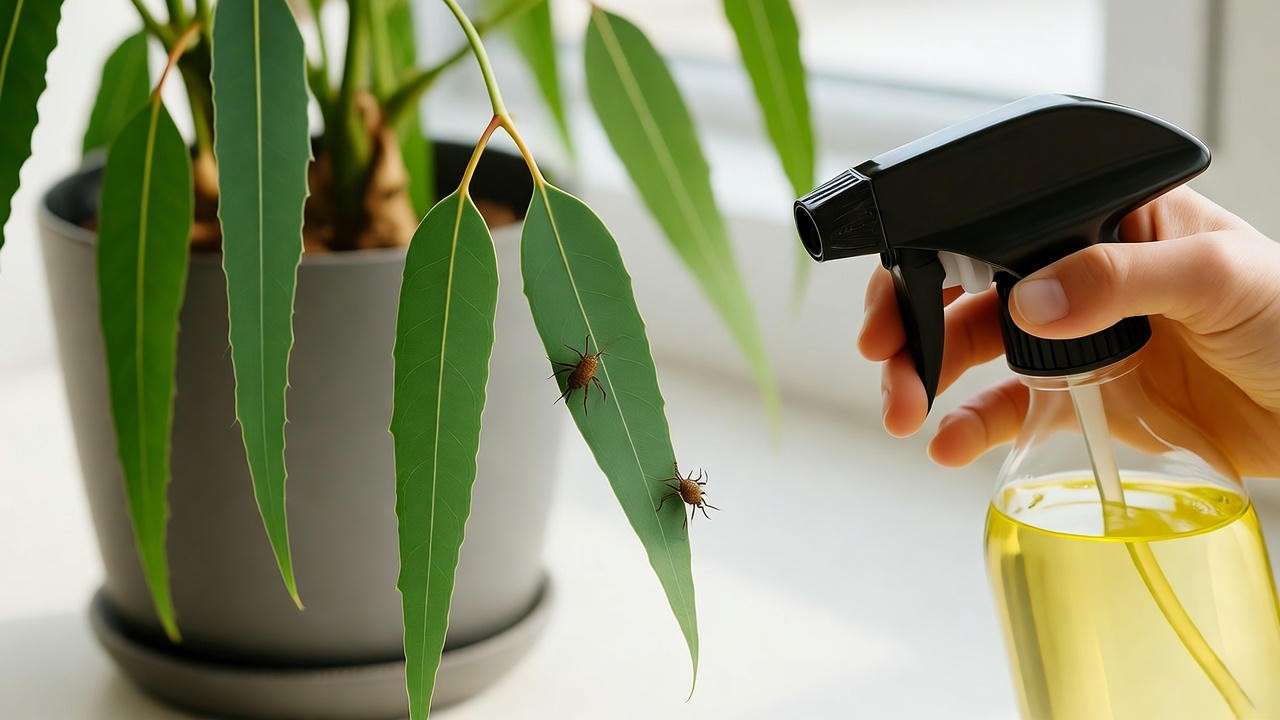
5.2. Diseases: Root Rot and Fungal Issues
Root rot, caused by overwatering or poor drainage, is a common issue for indoor eucalyptus. Symptoms include mushy roots, yellowing leaves, or a foul soil odor. To treat, remove the plant from its pot, trim away black or soft roots, and repot in fresh, well-draining soil. Ensure your pot has drainage holes and avoid letting it sit in water. Fungal issues, like powdery mildew, appear as white patches on leaves. Increase air circulation and reduce humidity around the plant to prevent fungi. If mildew persists, apply a diluted fungicide safe for indoor plants. Proper watering and soil care are your best defenses. 🌱
5.3. Leaf Drop and Yellowing: What’s Going Wrong?
Leaf drop or yellowing can signal stress in your eucalyptus. Common causes include:
- Overwatering: Soggy soil leads to yellow, drooping leaves. Check soil moisture and reduce watering.
- Underwatering: Dry, crispy leaves indicate thirst. Water thoroughly and adjust your schedule.
- Poor Light: Insufficient light causes pale, leggy growth. Move to a brighter spot or use a grow light.
- Nutrient Deficiency: Yellowing between veins may mean a lack of nutrients. Apply a balanced fertilizer.
Diagnose the issue by checking light, water, and soil conditions, then adjust care accordingly. With quick action, your plant can bounce back! 🌿
6. Creative Uses for Your Indoor Eucalyptus Plant 🎨
6.1. Decorating with Eucalyptus
A eucalyptus plant indoor doubles as a stunning decor piece. Its silvery-green leaves complement modern, bohemian, or minimalist aesthetics. Place it in a ceramic pot for a chic centerpiece on a coffee table or shelf. For special occasions, snip a few branches to create wreaths, garlands, or table arrangements. Pair with neutral-toned vases or baskets for a cohesive look. Position your plant near natural light to highlight its texture, instantly elevating your space’s ambiance. 🌸
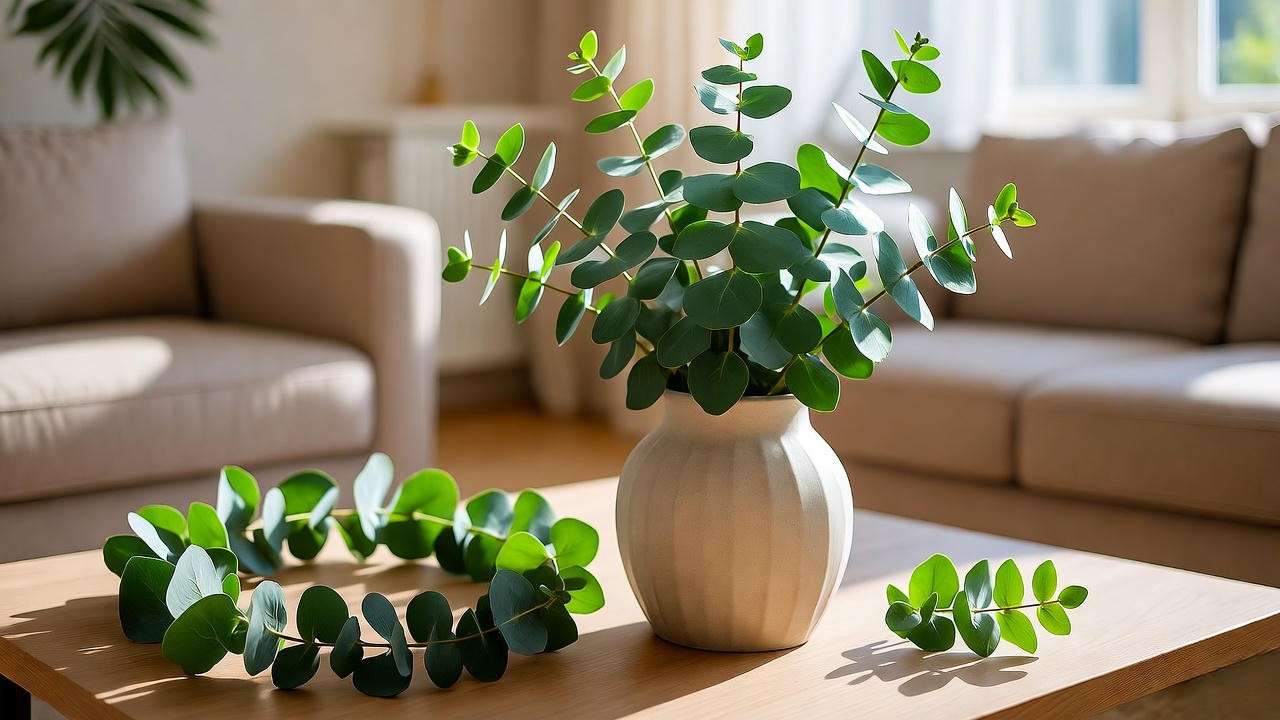
6.2. Harvesting Leaves for Aromatherapy
Eucalyptus leaves are a treasure for aromatherapy enthusiasts. To harvest, snip healthy, mature leaves from outer branches, taking no more than 10% of the plant at a time to avoid stress. Dry leaves by hanging them in a cool, dark place for 1–2 weeks. Use dried leaves in sachets, potpourri, or shower bundles—simply tie a bunch to your showerhead for a spa-like steam experience. For essential oil, consult a professional distiller, as DIY extraction requires specialized equipment. Always handle leaves gently to preserve their oils. 🌿
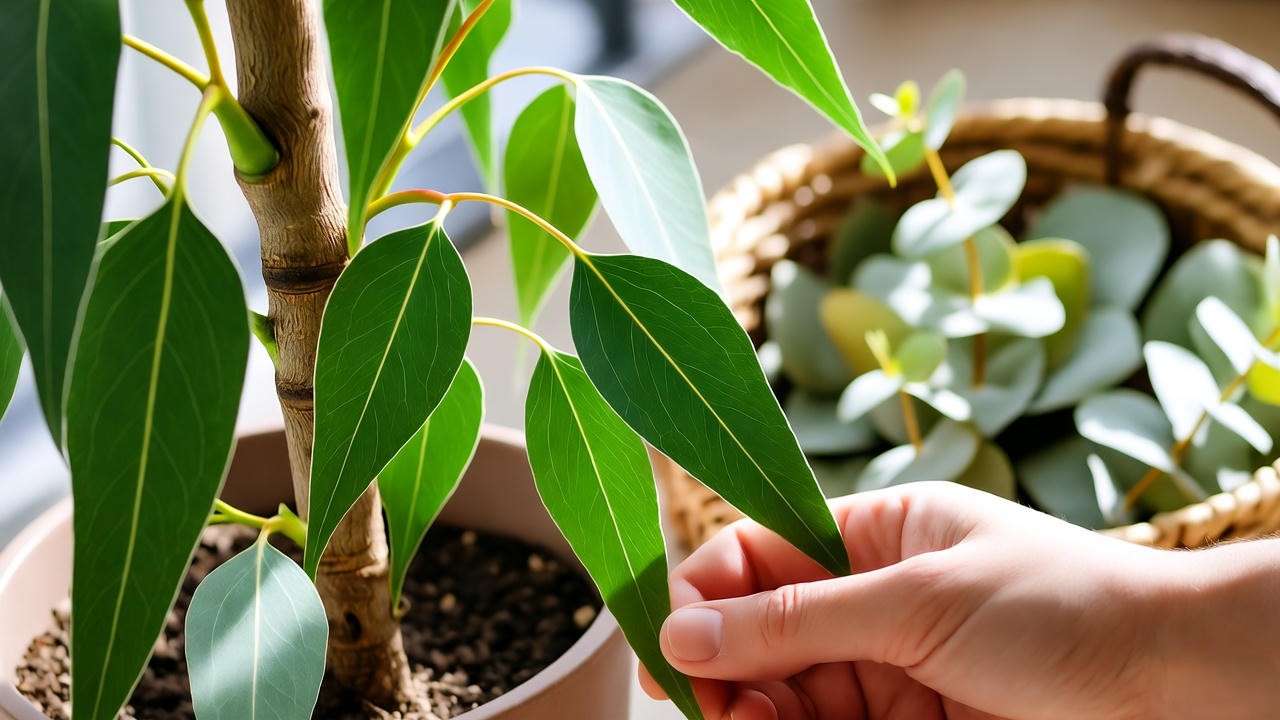
6.3. Gifting Eucalyptus: A Thoughtful Idea
Sharing your eucalyptus is a heartfelt gift for plant lovers. Propagate by taking 4–6-inch stem cuttings from healthy branches, removing lower leaves, and placing them in water or moist soil. Keep cuttings in bright, indirect light until roots form (2–4 weeks). Once rooted, pot them in well-draining soil and share with friends, along with a care card summarizing light, water, and soil tips. This thoughtful gesture spreads the joy of eucalyptus while showcasing your green thumb! 🎁
7. Expert Insights: Tips from a Plant Care Specialist 🌟
As a horticulturist with over 10 years of experience, I’ve grown eucalyptus plants in various indoor settings, from cozy apartments to spacious homes. One of my favorite memories is reviving a drooping Eucalyptus gunnii by adjusting its light and watering routine—it flourished into a lush centerpiece! Here are my top five mistakes beginners make and how to avoid them:
- Overwatering: Always check soil dryness before watering.
- Ignoring Light Needs: Ensure 6–8 hours of bright, indirect light.
- Skipping Pruning: Regular trims prevent legginess and promote fullness.
- Using Poor Soil: Opt for well-draining, slightly acidic mixes.
- Neglecting Humidity: Maintain 40–60% humidity for optimal growth.
Pro Tip: To encourage faster growth and fuller foliage, pinch back new growth tips monthly during spring. This stimulates branching and keeps your plant compact. 🌱
8. FAQs: Answering Your Burning Questions ❓
How fast does an indoor eucalyptus plant grow?
Indoors, eucalyptus grows slowly, about 6–12 inches per year, depending on light and care. Regular pruning keeps it manageable.
Can eucalyptus survive in low-light conditions?
Eucalyptus prefers bright light and struggles in low-light areas. Supplement with a grow light if natural light is limited.
Is eucalyptus safe for pets?
Eucalyptus is toxic to cats, dogs, and other pets if ingested. Keep it out of reach or opt for pet-safe plants if concerned.
How often should I repot my eucalyptus?
Repot every 1–2 years or when roots are cramped. Spring is the best time to refresh soil and pot size.
What’s the best way to revive a struggling eucalyptus plant?
Diagnose the issue (light, water, pests), adjust care, and trim dead growth. Patience and consistent care often restore health.
9. Conclusion: Your Path to a Thriving Indoor Eucalyptus 🌿
Growing a eucalyptus plant indoor is a delightful way to bring nature’s beauty and fragrance into your home. By providing bright light, well-draining soil, moderate watering, and occasional pruning, you’ll cultivate a thriving plant that enhances your space and well-being. Whether you’re decorating, crafting aromatherapy bundles, or sharing cuttings with friends, your eucalyptus will reward you with years of lush growth. Start with the tips in this guide, and don’t be afraid to experiment as you learn your plant’s unique needs. Share your eucalyptus journey in the comments or try our downloadable care checklist to stay on track! 🌱

